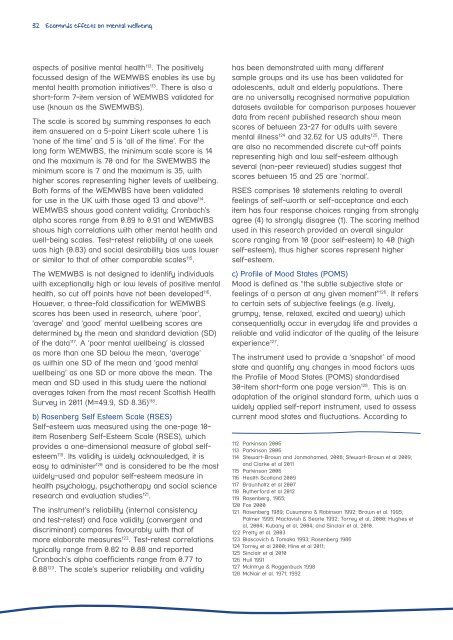Ecominds-effects-on-mental-wellbeing-evaluation-report
Ecominds-effects-on-mental-wellbeing-evaluation-report
Ecominds-effects-on-mental-wellbeing-evaluation-report
Create successful ePaper yourself
Turn your PDF publications into a flip-book with our unique Google optimized e-Paper software.
32 <str<strong>on</strong>g>Ecominds</str<strong>on</strong>g> <str<strong>on</strong>g>effects</str<strong>on</strong>g> <strong>on</strong> <strong>mental</strong> <strong>wellbeing</strong>aspects of positive <strong>mental</strong> health 112 . The positivelyfocussed design of the WEMWBS enables its use by<strong>mental</strong> health promoti<strong>on</strong> initiatives 113 . There is also ashort-form 7-item versi<strong>on</strong> of WEMWBS validated foruse (known as the SWEMWBS).The scale is scored by summing resp<strong>on</strong>ses to eachitem answered <strong>on</strong> a 5-point Likert scale where 1 is‘n<strong>on</strong>e of the time’ and 5 is ‘all of the time’. For thel<strong>on</strong>g form WEMWBS, the minimum scale score is 14and the maximum is 70 and for the SWEMWBS theminimum score is 7 and the maximum is 35, withhigher scores representing higher levels of <strong>wellbeing</strong>.Both forms of the WEMWBS have been validatedfor use in the UK with those aged 13 and above 114 .WEMWBS shows good c<strong>on</strong>tent validity; Cr<strong>on</strong>bach’salpha scores range from 0.89 to 0.91 and WEMWBSshows high correlati<strong>on</strong>s with other <strong>mental</strong> health andwell-being scales. Test-retest reliability at <strong>on</strong>e weekwas high (0.83) and social desirability bias was loweror similar to that of other comparable scales 115 .The WEMWBS is not designed to identify individualswith excepti<strong>on</strong>ally high or low levels of positive <strong>mental</strong>health, so cut off points have not been developed 116 .However, a three-fold classificati<strong>on</strong> for WEMWBSscores has been used in research, where ‘poor’,‘average’ and ‘good’ <strong>mental</strong> <strong>wellbeing</strong> scores aredetermined by the mean and standard deviati<strong>on</strong> (SD)of the data 117 . A ‘poor <strong>mental</strong> <strong>wellbeing</strong>’ is classedas more than <strong>on</strong>e SD below the mean, ‘average’as within <strong>on</strong>e SD of the mean and ‘good <strong>mental</strong><strong>wellbeing</strong>’ as <strong>on</strong>e SD or more above the mean. Themean and SD used in this study were the nati<strong>on</strong>alaverages taken from the most recent Scottish HealthSurvey in 2011 (M=49.9, SD 8.36) 118 .b) Rosenberg Self Esteem Scale (RSES)Self-esteem was measured using the <strong>on</strong>e-page 10-item Rosenberg Self-Esteem Scale (RSES), whichprovides a <strong>on</strong>e-dimensi<strong>on</strong>al measure of global selfesteem119 . Its validity is widely acknowledged, it iseasy to administer 120 and is c<strong>on</strong>sidered to be the mostwidely-used and popular self-esteem measure inhealth psychology, psychotherapy and social scienceresearch and evaluati<strong>on</strong> studies 121 .The instrument’s reliability (internal c<strong>on</strong>sistencyand test-retest) and face validity (c<strong>on</strong>vergent anddiscriminant) compares favourably with that ofmore elaborate measures 122 . Test-retest correlati<strong>on</strong>stypically range from 0.82 to 0.88 and <strong>report</strong>edCr<strong>on</strong>bach’s alpha coefficients range from 0.77 to0.88 123 . The scale’s superior reliability and validityhas been dem<strong>on</strong>strated with many differentsample groups and its use has been validated foradolescents, adult and elderly populati<strong>on</strong>s. Thereare no universally recognised normative populati<strong>on</strong>datasets available for comparis<strong>on</strong> purposes howeverdata from recent published research show meanscores of between 23-27 for adults with severe<strong>mental</strong> illness 124 and 32.62 for US adults 125 . Thereare also no recommended discrete cut-off pointsrepresenting high and low self-esteem althoughseveral (n<strong>on</strong>-peer reviewed) studies suggest thatscores between 15 and 25 are ‘normal’.RSES comprises 10 statements relating to overallfeelings of self-worth or self-acceptance and eachitem has four resp<strong>on</strong>se choices ranging from str<strong>on</strong>glyagree (4) to str<strong>on</strong>gly disagree (1). The scoring methodused in this research provided an overall singularscore ranging from 10 (poor self-esteem) to 40 (highself-esteem), thus higher scores represent higherself-esteem.c) Profile of Mood States (POMS)Mood is defined as “the subtle subjective state orfeelings of a pers<strong>on</strong> at any given moment” 126 . It refersto certain sets of subjective feelings (e.g. lively,grumpy, tense, relaxed, excited and weary) whichc<strong>on</strong>sequentially occur in everyday life and provides areliable and valid indicator of the quality of the leisureexperience 127 .The instrument used to provide a ‘snapshot’ of moodstate and quantify any changes in mood factors wasthe Profile of Mood States (POMS) standardised30-item short-form <strong>on</strong>e page versi<strong>on</strong> 128 . This is anadaptati<strong>on</strong> of the original standard form, which was awidely applied self-<strong>report</strong> instrument, used to assesscurrent mood states and fluctuati<strong>on</strong>s. According to112 Parkins<strong>on</strong> 2006113 Parkins<strong>on</strong> 2006114 Stewart-Brown and Janmohamed, 2008; Stewart-Brown et al 2009;and Clarke et al 2011115 Parkins<strong>on</strong> 2006116 Health Scotland 2009117 Braunholtz et al 2007118 Rutherford et al 2012119 Rosenberg, 1965;120 Fox 2000121 Rosenberg 1989; Cusumano & Robins<strong>on</strong> 1992; Brown et al. 1995;Palmer 1995; Mactavish & Searle 1992; Torrey et al, 2000; Hughes etal, 2004; Kubany et al, 2004; and Sinclair et al, 2010.122 Pretty et al. 2003123 Blascovich & Tomaka 1993; Rosenberg 1986124 Torrey et al 2000; Hine et al 2011;125 Sinclair et al 2010126 Hull 1991127 McIntrye & Roggenbuck 1998128 McNair et al. 1971; 1992



